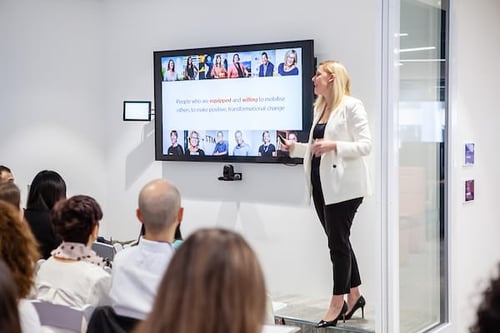
3 min read
Whenever I encounter amazing speakers at a conference or seminar, I leave the event with my mind full of inspiration. Like many people leaders, I’m interested in implementing ideas that are going to set my team up in an environment to do the best work of their lives.
Earlier in my career, I found that whenever the ideas I wanted to implement required buy-in from other parts of the business, I knew that I had a big challenge ahead of me. It was never easy to suggest something new if I knew there was a sceptic in the room who was ready to question anything that required them change.
Change is something that is often met with resistance because it’s hard, slow and usually stressful. It probably doesn’t come as a surprise that Harvard Business Review reports a whopping 70% of change efforts fail.
What does it take to be part of the successful 30%? What does it take to get employees and leadership on our side, to have them understand what we were trying to achieve and are excited to join us on the journey?
After years of working with successful HR leaders to develop and implement impactful engagement programmes and strategies to achieve long-lasting cultural change in their organisations, these are the four key traits that I’ve observed successful HR professionals have in common:
1. They understand the world of stakeholder adoption has changed
Gone are the days you could meet with the CEO and ask for their tick of approval for projects that impact the entire business. Today, HR leaders require buy-in from an average of 5.7 stakeholders – often this includes leaders in the Finance, IT and even Marketing teams.
With every additional stakeholder that needs to give their yes, the likelihood of approval drops significantly. That’s why it’s critical to understand how to build the business case for HR initiatives.
Successful HR professionals know that gaining buy-in is more complex than ever before – but instead of being deterred, they embrace the challenge.

2. They go left when others go right
The traditional approach to getting consensus involved meeting with each stakeholder and pitching a change project based on each party’s unique goals and metrics. But research shows this approach is more likely to get an individual “yes” from your 5-6 stakeholders, but a collective “no” at crunch time.
Instead, HR professionals spend their time looking for common ground. They focus their efforts and initiatives on areas where their stakeholders can agree on a common vision, purpose and benefit.
3. They challenge the current state
Because HR professionals know that their stakeholders only have about 5% of common ground, they don’t spend too much time painting a picture of what the “ideal future state” might look like – this might look very different for people who work in different parts of their business.
Successful HR professionals break the disengagement cycle by looking at the current state first and teaching their teams something new about it, or giving them a different perspective on it.
This might involve digging a bit deeper and looking at the underlying causes of cultural issues, or looking at current initiatives and providing ideas about how to evolve an existing engagement programme in order to grow with the needs of a business. 
4. They embrace the different types of stakeholders – especially the sceptics
In addition to looking for advocates to help champion their change initiatives, successful HR professionals encourage the sceptics to speak up and speak out.
They know that once a sceptic has the right information and proof, they can actually be a powerful ally for change. They mobilise these people and transform 'why nots' into 'what ifs.'
Sometimes, people who appear to be blocking your change project are simply trying to understand why it’s worth their time and attention. Listening carefully to their questions can be a powerful disarmer, but also give you an opportunity to articulate your business case and show the sceptics that recognition really works.
Overall, effective HR professionals, those who create transformational change, are not one to back down when a challenge is presented. They don’t let resistors dull the energy and excitement of their vision. Instead, they identify who they need to get on board and use these four tactics to start a ripple that becomes the wave of impactful, long-lasting change and shows the value of employee recognition.
Wishing you the best of luck of your change journey,
Kylie

 Kylie Green
Kylie Green

